KINO SIEMENSSTADT- The complex of Labour
Jaro Straub, founder of the project space Scharaun, together with Olaf Stüber (Videoart at Midnight) has put together an exciting online film series, entitled KINO SIEMENSSTADT – The complex of Labour. Set against the architectural backdrop of Berlin reform settlement Siemensstadt, the film program deals with the question “How can motion picture best present a discourse on labour?”
This is the perfect opportunity to take a closer look at Scharaun, an interdisciplinary project space for art and architecture, located on the 3rd floor of the residential complex at Jungfernheideweg 4 in Berlin-Siemensstadt, which was designed by Hans Scharoun and completed in 1930. Scharoun himself lived and worked in the house for 30 years with his wife Aenne. In his feature, originally recorded for RBB Kultur, Tomas Fitzel takes us on a tour to this amazing treasure of Berlin’s architectural history.
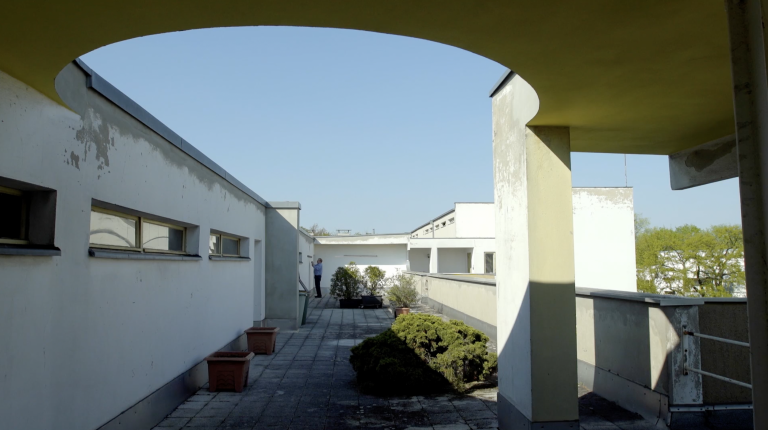
On the roof top of Hans Scharoun’s “Panzerkreuzer”, video still from: SIEDLUNGEN – ein gebautes Versprechen, 2018
Along the Nonnendammallee rushes the dense six-lane traffic, dreary and battered lies the first shopping center in Germany from the early sixties. While turning into adjacent Jungfernheideweg, one can see these white apartment blocks with their curved roof lines with their round balconies, an architecture – on the one hand reminiscent of Arab settlements and on the other hand of ships. In fact, this apartment block is also called as „Battleship“ (Panzerkreuzer). The block across the street begins narrowly on the street, then runs off at an angle and loses itself behind tall trees. Full of surprise, one reads on an information board that these modern-looking houses were built in the late 1920s and with even more surprise that the famous architect Hans Scharoun himself lived here from 1930 until 1960, since these housing estates always have the stigma of being socially precarious. The staircase is small and not at all representative, and then above there is the apartment that Jaro Straub discovered by chance four years ago.
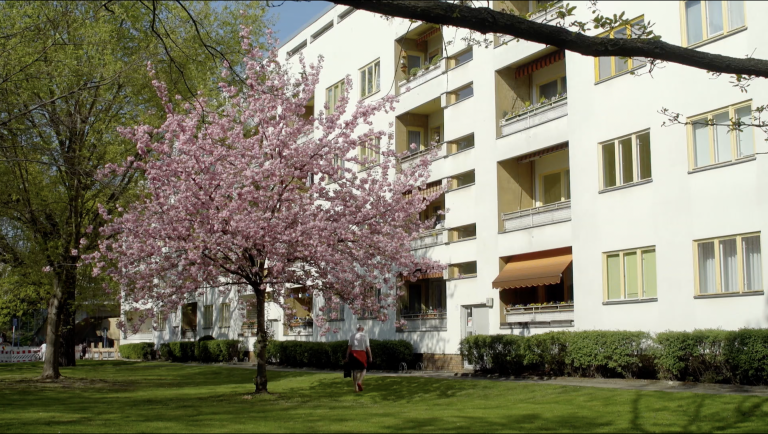
Jungfernheidweg at Siemensstadt, video still from: SIEDLUNGEN – ein gebautes Versprechen, 2018
“I’m always amazed at how visionary this floor plan is, how special this apartment is for its small size of only 67 square meters. We don’t know today if Scharoun has planned ahead to move into the building, since he must have thought I can afford this apartment. 1930 was a difficult year for Scharoun, as he had lost his professorship in Breslau at the School of Arts and Crafts.”
Scharoun then stayed here for thirty years with his wife. Kitchen, bathroom and hallway are completely limited to the minimum of space, but the generous living room with balcony (…) and the special window to both celestial sides, which means a lot of light.
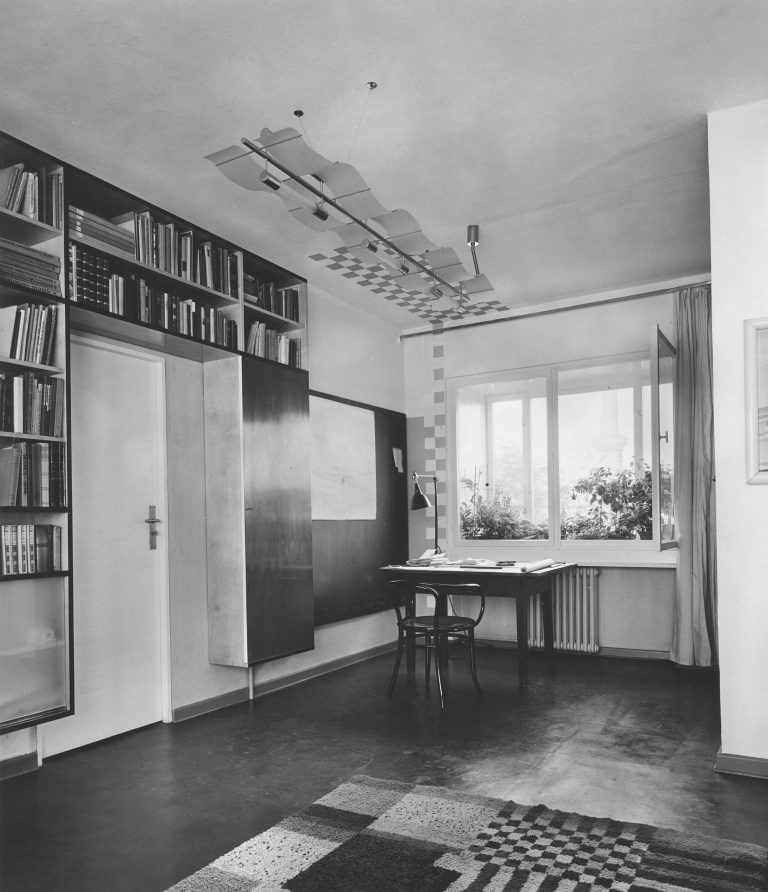
View into the living room, Courtesy Baukunstarchiv of Akademie der Künste, Berlin.
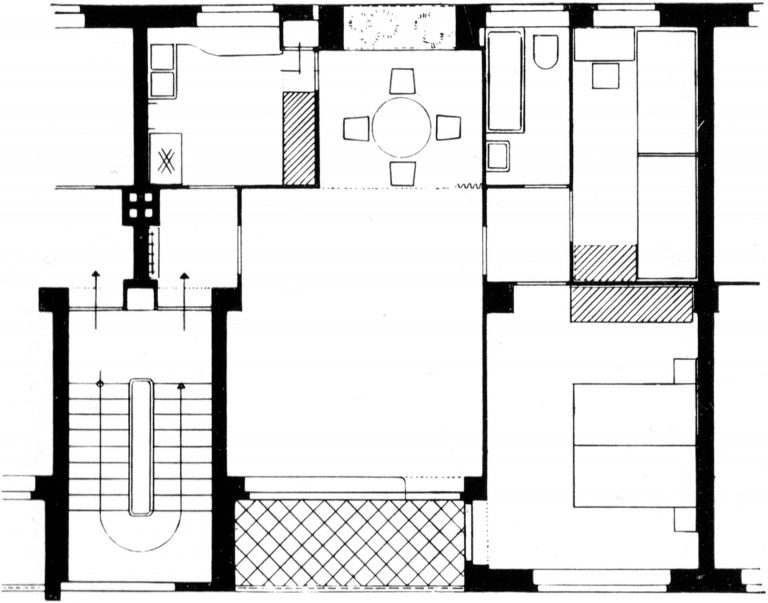
Floor plan of the apartment, 1930, Courtesy Baukunstarchiv of Akademie der Künste, Berlin.
Jaro Straub comes from southern Germany and is a visual artist who works with architecture, photography and film, but also with collages, especially influenced by Hannah Höch. He is the initiator of the exhibition series Verschollene Collagen (von Hannah Höch) together with Martin G. Schmid at Scharaun 2018, Shedhalle Zürich and MEWO Kunsthalle Memmingen 2019 and Kunstverein Pforzheim 2021. Hannah Höch as well as Hans Scharoun have to do with his own biography and therefore this apartment immediately seemed strangely familiar to him when he first entered.
“I’ve known this kind of architecture from an early age. My grandfather was a furniture manufacturer and contacted Scharoun in the 1950s. As he wanted to build a special house, Scharoun was already in the preparations for the Philharmonie and then wrote to him: I’m not doing anything like that at the moment, but I know a very good young talented architect named Chen Kuen Lee, of Chinese origin. Write to him sometime. And that’s how this contact came about. (…) Lee himself worked with Scharoun in this apartment in the 1930s.”
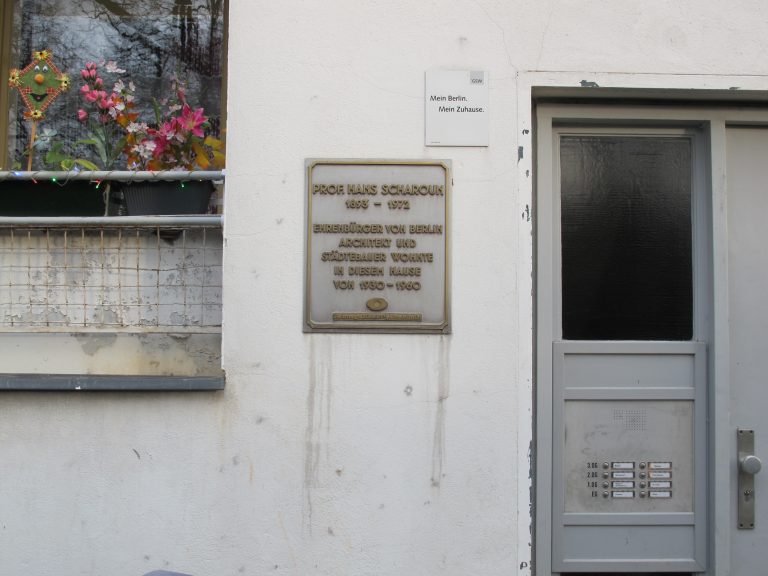
Entrance at Jungfernheidweg 4, video still from: SIEDLUNGEN – ein gebautes Versprechen, 2018
In the archive room of Scharaun one encounters furniture designed by Chen Kuen Lee, which Jaro Straub brought to Berlin from his grandfather’s house.
“Because I was personally acquainted with Lee, I still knew these stories, that there was a lot of activity here, also in this apartment, that is, in the house where we are now, especially during the war, when it was almost impossible to get building assignments, there was an initiative of architect friends, who met on a regular basis and who tried to foresee the Berlin of the future, as they were in a kind of waiting position, asking what will happen when the war is over and what will happen when we can finally build again.”
Even now we are in a kind of strange waiting position during the pandemic, waiting for normality to return. Jaro Straub, however, quickly moved ahead after just one month.
“Back then, in April 2020 I started to reorganize my website, and then eventually started an online cinema, called Kino Siemensstadt. There was a cinema with the same name here until the 1960s, but it doesn’t exist anymore.”
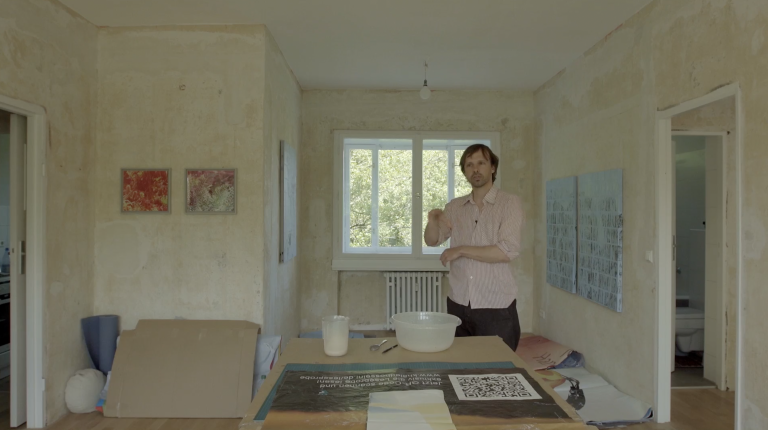
Jaro Straub at Scharaun, video still from: SIEDLUNGEN – ein gebautes Versprechen, 2018
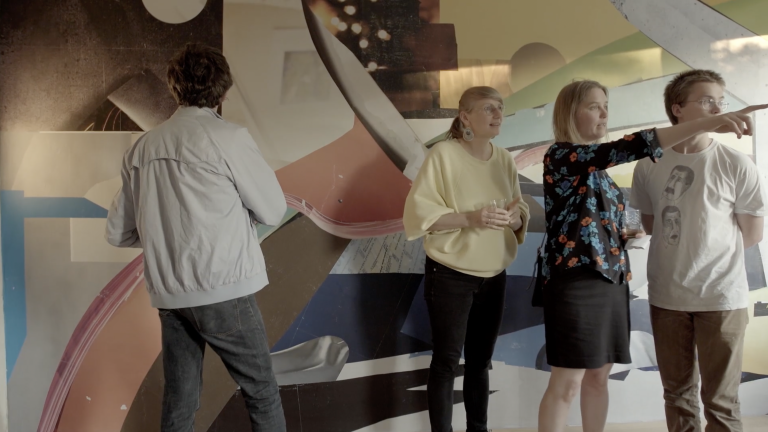
Exhibition Verschollen Collagen (von Hannah Höch) at Scharaun, video still from: SIEDLUNGEN – ein gebautes Versprechen, 2018
The film program is free and available for online streaming in ten thematic blocks at scharaun.de for one week at a time. An overview and a summary of the program weeks #1 and #2 can be found here.
Photos: SIEDLUNGEN – ein gebautes Versprechen 2018, Idea & Concept: Thomas Krüger, Director: Marian Engel
Auf der Nonnendammallee rauscht der dichte sechsspurige Verkehr, trist und ramponiert liegt da das erste Einkaufszentrum Deutschlands von Anfang der sechziger Jahre, dann biegt man in den Jungfernheideweg ein, sieht diese weißen Wohnblöcke mit ihren geschwungenen Dachlinien, den runden Balkonen, eine Architektur die einerseits an arabische Siedlungen und andererseits an Schiffe erinnert. Tatsächlich wird dieser Wohnblock auch Panzerkreuzer genannt. Der Block gegenüber beginnt schmal an der Straße, läuft dann schräg weg und verliert sich hinter hohen Bäumen. Erstaunt liest man auf einer Informationstafel, dass diese so modern wirkenden Häuser bereits Ende der 20er Jahren errichtet wurden und noch mehr überrascht dass der berühmte Architekt Hans Scharoun hier selbst von 1930 bis 1960 gewohnt hat, haben doch diese Siedlungsbauten stets das Stigma des sozial prekären an sich. Das Treppenhaus klein und überhaupt nicht repräsentativ und dann die Wohnung die Jaro Straub vor vier Jahren zufällig entdeckt hat.
Jaro Straub: “Ich bin immer wieder erstaunt wie toll dieser Grundriss, wie besonders diese Wohnung für die kleine Größe von 67 qm ist. Wir wissen heute nicht, ob Scharoun den Einzug in das Gebäude geplant hat, da er wohl dachte, ich kann mir diese Wohnung leisten. 1930 war eine schwierige Zeit für Scharoun, er hatte damals seine Professur in Breslau an der Kunst und Gewerbeschule verloren.
Scharoun blieb dann dreißig Jahren lang hier mit seiner Frau wohnen, Küche, Bad und Flur sind ganz auf den minimalsten Raum beschränkt, dafür großzügig der Wohnraum mit Balkon (…) und das besondere Fenster nach beiden, das heißt viel Licht.”
Jaro Straub stammt aus Süddeutschland und ist Bildender Künstler, der sich mit Architektur, Fotografie und Film beschäftigt aber auch mit Collagen und da besonders von Hannah Höch. Er ist Initiator der Ausstellungsreihe Verschollene Collagen (von Hannah Höch) zusammen mit Martin G. Schmid in Scharaun 2018, Shedhalle Zürich und MEWO Kunsthalle Memmingen 2019 und Kunstverein Pforzheim 2021. Sowohl Hannah Höch als auch Hans Scharoun haben mit seiner eigenen Biografie zu tun und so kam ihm diese Wohnung beim ersten Betreten sofort seltsam vertraut vor.
“Ich kenne diese Art von Architektur von Kleinauf. Mein Großvater war Möbelfabrikant und hat in den 50er Jahren Scharoun mal kontaktiert. Und er wollte ein besonderes Haus bauen, Scharoun war schon in den Vorbereitungen für die Philharmonie und hat ihm dann geschrieben: Ich mache so etwas im Moment nicht, aber ich habe einen sehr guten jungen talentierten Architekten namentlich Chen Kuen Lee, chinesischer Herkunft. Schreiben Sie ihm mal. Und so kam dieser Kontakt zustande. (…) Lee hat selbst in den 1930er Jahren mit Scharoun in dieser Wohnung gearbeitet.”
Im Archivraum von Scharaun stehen jetzt auch von Chen Kuen Lee entworfene Möbel, die Jaro Straub aus dem Haus seines Großvaters nach Berlin mitgebracht hat.
“Weil ich mit Lee noch persönlich bekannt war, kannte ich diese Geschichten noch, dass es hier sehr viele Aktivitäten gab auch in dieser Wohnung, also in dem Haus wo wir jetzt gerade sind, insbesondere während der Kriegszeit als es fast unmöglich war zu bauen, gab es eine Initiative von befreundeten Architekten, die haben sich getroffen, die haben versucht das Berlin der Zukunft vorauszusehen, also die waren in so einer Art Wartestellung, was passiert wenn der Krieg zu Ende ist, was passiert wenn wir endlich wieder bauen können.”
Auch jetzt sind wir in einer Art merkwürdigen Wartestellung, warten dass die Normalität wieder eintritt. Jaro Straub hat sich aber schon nach einem Monat schnell umgestellt.
“Dann habe ich im April 2020 angefangen mich über meine Internetseite www.scharaun.de umzugestalten, und schließlich ein Online-Kinoprogramm gestartet, das Kino Siemensstadt heißt. Bis in die 1960er Jahre gab es hier einmal ein Kino gleichen Namens, aber das gibt es nicht mehr.”
Fotos: SIEDLUNGEN – ein gebautes Versprechen 2018, Idee & Konzept: Thomas Krüger, Regie: Marian Engel
